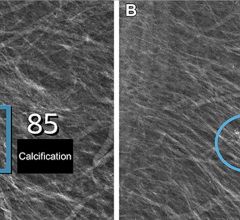January 2, 2013 — Imaging Diagnostic Systems Inc. announced that Clinical Imaging has reviewed and accepted a paper that evaluates the results of CTLM(R) and mammography when imaging dense breasts.
The recent paper accepted by Clinical Imaging focuses on imaging women with heterogeneously and extremely dense breast tissue using both mammography and CTLM(R). CTLM(R) is an innovative 3-D laser breast imaging system that utilizes diffuse optical tomography or "DOT" technology. The study demonstrated that the addition of a CTLM(R) scan to a mammogram improved sensitivity rates of detecting breast abnormalities considerably. The sensitivity rates ranged from 34.4 percent for mammography alone to 81.57 percent when CTLM(R) was added. Equating to over double the sensitivity to detect abnormalities when imaging extremely dense breasts (ACR BIRADS 4 breast composition classification). To access the free abstract and the complete clinical paper for purchase, please go to www.clinicalimaging.org and search under the heading for either "CTLM" or "CTLM as an adjunct to mammography in the diagnosis of patients with dense breast." Globally, 40-50 percent of the female population has mammographically dense breasts and these recent results present the potential of CTLM(R) to assist the imaging needs of women with any breast density.
Clinical Imaging provides widespread coverage of innovative technology, new applications and important issues concerning all diagnostic imaging techniques. The journal investigates the relative merits of established and developing diagnostic imaging technology, with regard to cost effectiveness, safety and propriety where specific disorders and physiological systems are concerned. Clinical Imaging is a radiologist peer reviewed publication. From ultrasound to MRI, Clinical Imaging provides crucial information for radiologists, radiology residents, and radiologic technologists.
The paper's author, Dr. Jin Qi remarks, "Our data indicated that the imaging of CTLM(R) was least affected by tissue density in breasts and provides information about angiogenesis in breast lesions, especially in malignant lesions, when used as an adjunct to mammography in heterogeneously dense breasts and extremely dense breasts, sensitivity increased significantly." Qi concluded, "this is a feature that could have a positive impact on women's imaging across the globe." Qi is deeply involved with breast cancer in China and works in the following departments; Radiology Department at Tianjin Medical University Cancer Institute and Hospital, Key Laboratory of Breast C ancer Prevention and Therapy of the Ministry of Education, and Key Laboratory of Cancer Prevention and Therapy.
CEO of Imaging Diagnostic Systems Inc., Linda Grable states, "IDSI is very excited and honored to have a CTLM(R) paper accepted by a leading, well respected American diagnostic imaging publication. The results display the capability of CTLM(R) to be less impeded by dense breast tissue than mammography and will eventually provide radiologists with a complimentary non radiation based imaging tool; especially when dealing with dense breast tissue. And the additional patient benefits consisting of no radiation, no breast compression, and no injected contrast agents will hopefully aide with women's imaging needs globally."
For more information, visit our website: www.imds.com


 July 29, 2024
July 29, 2024 








